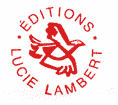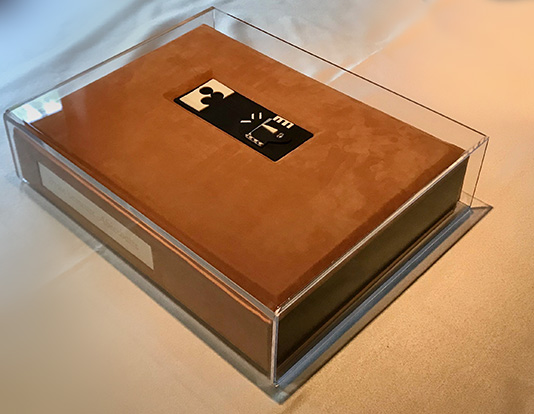![]()
Click on the image below to return to the book thumbnails
| French text follows |
|
Vraie demeure, abécédaire 2018 Pierre Nepveu
From our earliest childhood experiences reciting it – often in song – the alphabet feels like a journey. Everyday expressions make this apparently meaningless series of letters into a metaphor for learning, progress, a complete set of events chanted from beginning to end. We talk about the “ABCs” of a skill or body of knowledge. We say a subject has been covered, or a project has been completed “from A to Z,” and in the expressions “D-Day” and “generation X,” the letters point to a decisive event, an era. The alphabet is never far from storytelling, and the characters, one following the other, convey a sense of the passage of time. Lucie Lambert’s images had the advantage of opening out this succession in a highly varied way, with abrupt changes in tone or atmosphere. With each image, a new space was opened up, but in contrast to the unalterable order of the letters was the utterly random, unpredictable nature of the forms that went with them: a grid, a floral pattern, broken lines like needlepoint, a splatter of ink, a whorl of dots, a cloud, a mass of geometric shapes. Rather than places, they were motifs, and I found great inspiration in the way they seemed to vibrate. Vibration naturally evokes life: it takes us back to its first stirrings and the promise of its irrepressible fertility. Thus, through these images, I began to see the alphabet as something with meaning, with movement, as if each letter could now draw from a primordial material, from a kind of organic depth out of which, on each page, there emerged a moment of life, a state of consciousness, an event. These were often happy, although there could also be darker, sadder stations, because this adventure through the letters and images brought twists and turns and obstacles, too. Paradoxically, I was just as strongly motivated by what appeared to me as a hurdle or a rebuff, right from the very first letters. Perhaps by chance, the images corresponding to “a” and “c” suggested to my eyes a grate, a fence, a cloister. It was as if from the outset, the desire to travel, to walk freely over an open space, was confronted with the need to overcome the force of inertia. Is it not true that when we make a start at something, we almost always face a test of this kind – a wall that we must find our way past, even if it is simply a wall of silence? To walk freely, to travel: what, then, you may be wondering, is the true abode referred to in my title? I believe this idea of a dwelling-place can carry many meanings. Sometimes it might be a garden, a park where a child’s voice rings out, an orchard where we once picked apples with a loved one. We all have abodes of this kind, where our memory takes us again and again. However, are not all the spaces and experiences we pass through, and above all the time it takes for us to do so, also dwelling-places? Throughout the writing of this collection, carried along by the progression of the alphabet, I often felt as if I was inhabiting the movement itself, at one with the momentum that continually pulled me away from one image to bring me face to face with the next. To put it in another way: as I wrote, I believe I inhabited the very joy of becoming and travelling. Finally, while the alphabet is a universe unto itself, while its twenty-six letters allow us to say everything there is to say, it is language, with the world it seeks to embrace, that more broadly comprises the true abode. But here we are no longer in a house or a garden: we live in the universe itself, ever expanding toward infinity. Pierre Nepveu Pour Lucie Lambert L’alphabet n’a-t-il pas évoqué, dès nos premières récitations, souvent chantées, à l’âge de l’enfance, un certain parcours? Des expressions de la langue commune font de cette suite des lettres apparemment sans signification propre la métaphore d’un apprentissage, d’un cheminement, d’une totalité scandée d’événements. Ainsi en est-il de l’ « abc » d’une technique ou d‘un savoir, ou encore d’une communication accomplie, d’un travail réalisé « de a à z », quand ce n’est pas le système « D » et le jour « J » qui font de ces lettres l’indice d’un travail ou d’un événement décisif. L‘alphabet n’est jamais loin de la narration, la succession des caractères évoque le temps. Les images de Lucie Lambert avaient l’avantage de déployer cette succession sur le mode de la diversité, selon des changements brusques de tonalité ou d’atmosphère. Chaque fois, un nouvel espace s’ouvrait, mais à l’ordre immuable des lettres s’opposait le caractère tout à fait aléatoire et imprévisible des formes proposées : grille, massif floral, tapisserie pointillée, éclaboussure, tourbillon de points, nuage, tissu de formes géométriques. Ce n’étaient pas des lieux mais plutôt des motifs dont la nature vibratoire m’a beaucoup inspiré; car la vibration évoque naturellement la vie, elle en est comme le premier balbutiement et la promesse de son irrépressible fertilité. Un voyage, une marche : on peut se demander dès lors quelle est cette vraie demeure nommée par mon titre. Je crois que l’on peut donner plusieurs sens à cette idée d’une habitation. Ponctuellement, ce peut être un jardin, un parc où résonne la voix d’un enfant, un verger où l’on a cueilli des pommes avec l’être aimé. Nous connaissons tous des demeures de ce genre, auxquelles notre mémoire ne cesse de nous ramener. Pourtant, la traversée des lieux et des expériences, et surtout le temps nécessaire à son accomplissement, cela n’est-il pas également habitable? Tout au long de l’écriture de ce recueil, porté par l’avancée de l’alphabet, j’avais souvent l’impression d’habiter le mouvement lui-même, de coïncider avec l’élan qui ne cessait de m’arracher à une image pour me confronter à la suivante. Pour le dire autrement : j’habitais alors, je crois, le bonheur même de devenir et de voyager. Finalement, si l’alphabet est à lui seul un univers, si ses vingt-six lettres permettent de tout dire, alors c’est la langue elle-même, avec le monde qu’elle veut embrasser, qui constitue plus largement la vraie demeure. Mais ici, nous ne sommes plus dans une maison ou un jardin, nous résidons dans l’univers lui-même, en expansion vers l’infini. Juillet 2018 |

Lucie
Lambert Editions , BC, Canada ![]() TEL/
FAX 604-732-9389 info@lucielambert.com
TEL/
FAX 604-732-9389 info@lucielambert.com
